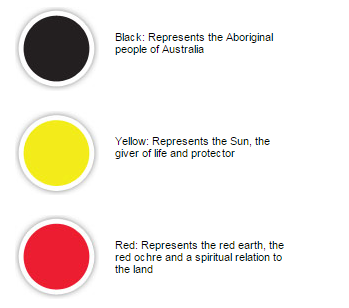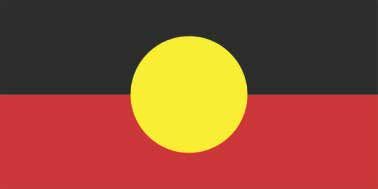Aboriginal Flag History & Colours
Carroll & Richardson Flagworld have the exclusive rights to manufacture the Australian Aboriginal Flag.
We produce it in a range of different sizes, styles, material and finishes to suit your needs.
Click aboriginal flag to shop the full range.
Created by Harold Thomas 1971
© Commonwealth of Australia
Aboriginal Flag made under an exclusive licence held by Carroll & Richardson Flagworld
Aboriginal Flag Colours and Symbolic Meaning
The symbolic meaning of the flag colours (as stated by Mr Harold Thomas) are:


Aboriginal Flag History
The Aboriginal flag was first flown on National Aborigine’s Day in Victoria Square in Adelaide on 9 July 1971. It has also been used in Canberra at the Aboriginal Tent Embassy since 1972.
Cathy Freeman caused controversy at the 1994 Commonwealth Games by waving both the Aboriginal flag and Australian National flag during her victory lap of the arena after winning the 200 meters sprint. The protocol at the time was that only a country’s national flag is meant to be displayed. Despite strong criticism, Freeman again carried both flags again after winning the 400 meter race.
The decision in 1995 by Prime Minister Paul Keating to make the Aboriginal flag a national flag (and later on the Torres Strait Islander flag) was opposed by many in the community, but successive governments have not overturned that decision and the Aboriginal flag now sits proudly alongside the Australian National Flag (blue ensign) and the Torres Strait Islander flag.
In 1997, the Federal Court of Australia declared that Harold Thomas was the owner of copyright in the design of the Aboriginal flag, and thus the flag has protection under Australian copyright law. Mr Thomas had sought legal recognition of his ownership and compensation following the Federal Government's 1995 proclamation of the design. His claim was contested by two others at the time, Mr. Brown and Mr. Tennant. Since then, Mr Thomas has awarded world rights solely to Carroll and Richardson Flagworld Pty Ltd for the manufacture and marketing of the flag.
The National Indigenous Advisory Committee campaigned for the Aboriginal flag to be flown during the 2000 Olympic Games. SOCOG announced that the Aboriginal flag would be flown at Olympic venues. The flag was also flown over the Sydney Harbour Bridge during the 2000 ‘March for Reconciliation”.
On the 30th anniversary of the flag in 2001, thousands of people carried the flag from the Parliament of South Australia to Victoria Square. Since 8 July 2002, after recommendations of the Council's Reconciliation Committee, the Aboriginal flag has been permanently flown in Victoria Square and the front of the Adelaide Town Hall.
Aboriginal Flag Uses
Many buildings in Australia now fly the Aboriginal flag (and Torres Strait Islander) as well as the Australian National flag. Various councils in Australian towns fly the Aboriginal flag from the town halls.
Carroll & Richardson Flagworld are the exclusive licensed manufacturer and provider of the Aboriginal Flag on flags and pennants, banners and buntings. We produce the Aboriginal Flag in a range of sizes, materials, and finishes to suit your needs. View our range of Aboriginal Flags here.
Created by Harold Thomas 1971, © Commonwealth of Australia.
History and Significance of the Aboriginal Flag
The Australian Aboriginal flag was designed by Aboriginal artist Harold Thomas in 1971. Over the years, it has become a powerful emblem of Indigenous identity and unity, and a symbol of pride and resilience for Indigenous communities across Australia.
Design and Symbolic Meaning
The symbolic meaning of the flag colours (as stated by Harold Thomas) is:
Black: Represents the Aboriginal people of Australia
Yellow circle: Represents the Sun, the giver of life and protector
Red: Representing the red earth and Aboriginal peoples' spiritual connection with the land; and representing the blood of the Aboriginal people

Origins and Early Usage
The rich history and cultural significance of the Aboriginal flag dates back to National Aborigine's Day in Victoria Square, Adelaide, on July 9, 1971. There, the flag was first raised at a land rights rally. The flag was also used at the Aboriginal Tent Embassy in Canberra from 1972.
Cathy Freeman captured global attention during the 1994 Commonwealth Games by waving both the Aboriginal flag and the Australian National flag as she triumphantly completed her victory lap after winning the 200-metre sprint. This iconic moment challenged the protocol at the time, which dictated that only the country's national flag should be displayed. Despite criticism, Freeman remained resolute, again carrying both flags after her victory in the 400-metre race.
Recognition as a National Symbol
In 1995, Prime Minister Paul Keating's decision to recognize the Aboriginal flag as a national emblem faced opposition. However, subsequent governments upheld the decision, and today, the Aboriginal flag flies proudly alongside the Australian National Flag and the Torres Strait Islander flag as "Flags of Australia" under the Flags Act 1953.
The proclamation of the Aboriginal Flag as a "Flag of Australia" states that the flag "is recognised as the flag of the Aboriginal peoples of Australia and a flag of significance to the Australian nation generally" and appointed "to be the flag of the Aboriginal peoples of Australia and to be known as the Australian Aboriginal Flag".
Ownership and Copyright
In a ruling by the Federal Court of Australia in 1997, Harold Thomas was granted ownership and copyright of the Aboriginal flag's design. This gave the design protection under Australian copyright law. Thomas had sought legal recognition of his ownership following the Federal Government's recognition of the flag in 1995. Following copyright protection, Thomas awarded rights solely to Carroll & Richardson Flagworld Pty Ltd for the manufacture of the flag.
On 25 January 2022, the Commonwealth government announced that the copyright of the Australian Aboriginal Flag was transferred from Mr Harold Thomas to the Commonwealth of Australia. Thomas retains moral rights to the flag, including the right to be identified as its creator.
As part of the Commonwealth copyright agreement, all royalties from the copyright are passed on to the National Aborigines and Islanders Day Observance Committee. The Commonwealth also agreed to fund a scholarship in Thomas' name for Indigenous students, an online education portal on the flag's history, and a not-for-profit organisation to make periodic payments for activities related to the flag.
The government stated on the use of the flag:
The Aboriginal Flag will now be managed in a similar manner to the Australian National Flag, where its use is free, but must be presented in a respectful and dignified way. All Australians can now put the Aboriginal Flag on apparel such as sports jerseys and shirts, it can be painted on sports grounds, included on websites, in paintings and other artworks, used digitally and in any other medium without having to ask for permission or pay a fee.
Carroll & Richardson Flagworld Pty Ltd remains the exclusive licensed manufacturer and provider of the Aboriginal Flag on flags and pennants, banners and buntings.
Memorable Moments
The National Indigenous Advisory Committee campaigned for the Aboriginal flag to be flown during the 2000 Olympic Games. The Sydney Organizing Committee for the Olympic Games (SOCOG) heeded the call, raising the flag at Olympic venues. Additionally, the flag adorned the Sydney Harbour Bridge during the 2000 'March for Reconciliation'. In February 2022, the New South Wales government announced that the flag would be flown from the Harbour Bridge permanently.
In a celebration of the flag's 30th anniversary in 2001, thousands of people carried the flag from the Parliament of South Australia to Victoria Square. Since July 8, 2002, in alignment with the recommendations of the Council's Reconciliation Committee, the Aboriginal flag has permanently flown in Victoria Square in front of the Adelaide Town Hall.
Ongoing Legacy
Today, the Australian Aboriginal Flag is popularly recognised as the flag of the Aboriginal peoples of Australia. It is flown or displayed around the country at Aboriginal centres, councils, government buildings, schools, business, and homes.
Flagworld manufacture and stock the Australian Aboriginal flag in a wide range of sizes, materials, and finishes. View our range here. If you have any questions or would like custom flag options, please talk to our friendly team.

